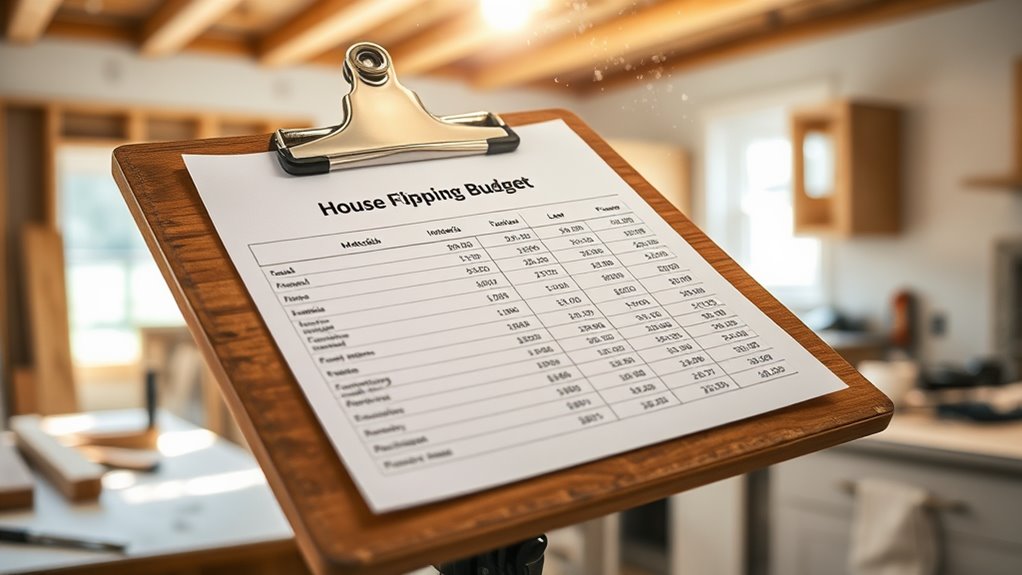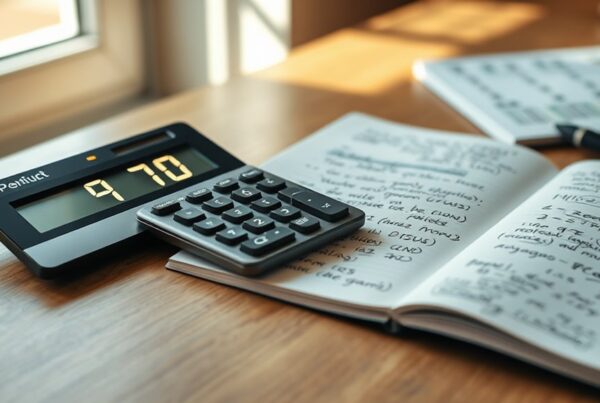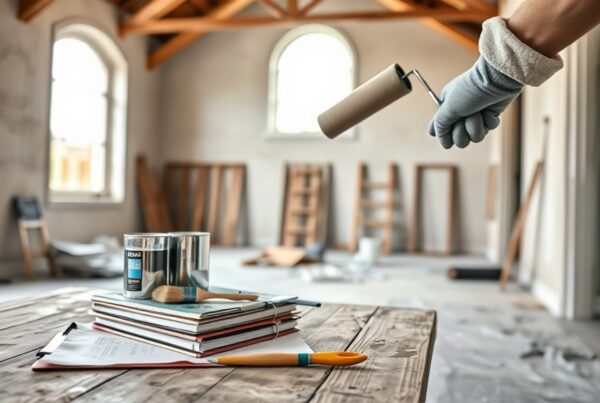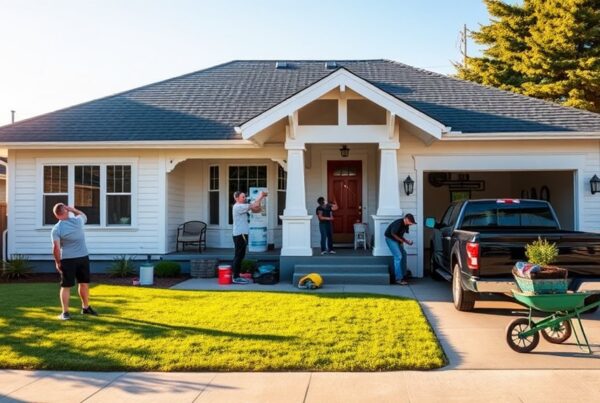The cost to flip a house averages between $20,000 and $70,000, depending on renovation scope and location. This estimate excludes the purchase price but includes necessary expenses like rehab work, closing costs, and holding fees for utilities, taxes, and insurance. To maximize profitability, you’ll need to account for unexpected costs, such as structural repairs or permit delays, while prioritizing high-return renovations like kitchen upgrades or curb appeal enhancements. Following the 70% rule—limiting your purchase to 70% of the after-repair value minus rehab costs—can help guarantee you stay within budget while maintaining a healthy profit margin. A well-managed house flip typically takes a few weeks to several months, but efficient project scheduling and cost management are critical to keeping expenses in check and achieving success in the competitive real estate market.
Key Takeaways
- The average cost to flip a house ranges from $20,000 to $70,000 excluding the purchase price.
- Renovation costs typically account for 10% of the purchase price.
- Closing costs add an additional 3% to 6% of the purchase price.
- Holding costs include mortgage payments, property taxes, and utilities, which can accumulate quickly.
- Total flipping costs, including purchase and renovations, average approximately $52,500.
How Much Does It Cost to Flip a House
When considering flipping a house, you’ll need to account for a wide range of expenses that extend beyond the initial purchase. The average cost to flip a house typically ranges from $20,000 to $70,000, excluding the home’s purchase price. Renovation costs alone often account for around 10% of the purchase price, so for a $150,000 home, you’d budget at least $15,000 for improvements. Closing costs add another 3% to 6% of the purchase price, further increasing your financial commitment. Holding costs, including mortgage payments, property taxes, and utilities, can also accumulate quickly, greatly impacting your profit margins if not carefully managed. On average, total flipping costs, including purchase, renovation, holding, and selling expenses, can amount to approximately $52,500. Understanding these costs guarantees you approach house flipping with a strategic and realistic financial plan, avoiding potential pitfalls that could erode your profits. Applying the 70% rule during the purchasing phase can help ensure you stay within budget and maximize potential profits.
Key Components of Flipping Costs
Your purchase price directly influences your budget and potential profit margins, so negotiating effectively is critical. Rehab essentials, including materials and labor, often account for a significant portion of your expenses and require careful planning to avoid overspending. Balancing these components guarantees you maximize returns while minimizing unnecessary costs. Utilizing a Fix and Flip calculator can assist you in estimating potential profits and costs more accurately.
Purchase Price Impact
The purchase price stands as the most critical factor influencing the overall cost structure in house flipping. When considering the cost to flip a house, you must aim to buy properties at no more than 70% of the after-repair value (ARV) minus renovation expenses. For example, if the ARV is $250,000 and renovations cost $50,000, your maximum purchase price shouldn’t exceed $125,000. Closing costs, typically 3% to 6% of the purchase price, must also be accounted for. Thorough market research and effective negotiation can greatly reduce your initial investment, freeing up budget for necessary upgrades and maximizing your ROI. A lower purchase price provides greater financial flexibility, ensuring you’re better positioned to handle unforeseen expenses during the project.
| ARV | Renovation Costs | Max Purchase Price |
|---|---|---|
| $250,000 | $50,000 | $125,000 |
| $300,000 | $60,000 | $150,000 |
| $350,000 | $70,000 | $175,000 |
Rehab Essentials
Rehabilitation costs form the backbone of flipping expenses, directly impacting your profit margins. When estimating how much does it cost to flip a house, allocate $20,000 to $70,000 for rehab, depending on the property’s condition and renovation scope. Building materials, cosmetic upgrades, and professional labor are key components, with total renovation costs averaging around 10% of the purchase price. Plan for $1,000 per day in renovation expenses; a $15,000 budget typically covers 15 days of work. Always set aside a contingency fund of 3-5% of your renovation budget to address unforeseen issues. Focus on cost-effective improvements that enhance resale value without overextending your budget. Strategic rehab planning guarantees you maximize returns while keeping costs under control. Regularly review market trends to adjust forecasts accordingly.
Strategies for Cost Management
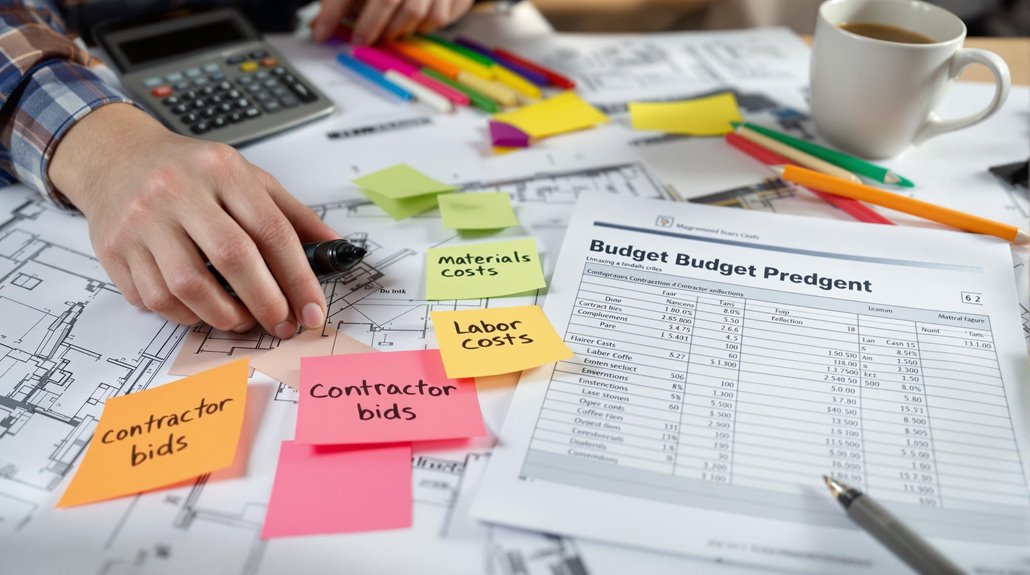
Focus on precise budget allocation by prioritizing high-impact renovations that boost property value while minimizing unnecessary expenses. Negotiate effectively with contractors and suppliers to secure competitive pricing, ensuring your project remains cost-efficient. Implement cost-effective solutions without compromising quality, such as repurposing materials or focusing on ideal design choices, to maintain profitability. Always adhere to the 70% rule when planning your budget to ensure financial safety and maximize returns.
Budget Allocation Tips
Allocating funds strategically is critical to avoid overspending and maximizing profitability when flipping a house. When determining how much does it cost to flip a home, confirm you allocate at least 10% of the purchase price for flipping costs, such as renovations and contingencies. Adhere to the 70% Rule by keeping your total expenses below 70% of the ARV minus repair costs. Creating an all-encompassing budget that includes purchase price, renovation, holding, and marketing expenses is essential, and you’ll need a contingency fund of 3-5% for unexpected costs. Consider zero-down payment options to minimize upfront financial strain and focus resources on renovations. Secure competitive labor quotes from multiple contractors to minimize spending. Regular accounting of holding costs like mortgage payments, property taxes, and utilities will safeguard your profit margins throughout the renovation period.
Negotiation Techniques
Just the content and the inline link formatting.
To manage costs effectively while flipping a house, mastering negotiation tactics can make a significant difference. Understanding how much do you need to flip a house is essential, and applying the 70% Rule guarantees your offer doesn’t exceed 70% of the ARV minus repair costs. Use comparative market analysis to justify lower purchase prices and seek multiple quotes from contractors to negotiate better rates. Including contingencies in purchase agreements protects against unexpected expenses, and building rapport with sellers can lead to more favorable terms. Ensuring legal adherence in all transactions will safeguard your investments and prevent potential disputes.
| Strategy | Purpose | Outcome |
|---|---|---|
| Apply the 70% Rule | Guarantee profitability | Maintain budget discipline |
| Use market data | Justify lower prices | Secure cost-effective deals |
| Compare contractor quotes | Negotiate labor and material rates | Maximize budget efficiency |
| Include contingencies | Cover unexpected costs | Reduce financial risks |
Cost-Effective Renovations
While renovating a house to flip, you’ll maximize profitability by prioritizing cost-effective strategies that enhance resale value without overspending. Start by adhering to the 70% Rule, guaranteeing your total expenses stay below 70% of the after-repair value minus repair costs. This helps you calculate a realistic offer price and manage how much a flip costs. Seek multiple contractor quotes to secure competitive pricing. Focus on high-return improvements like minor kitchen upgrades or bathroom remodels, which boost appeal without draining your budget. Allocate a 3-5% contingency fund to cover unforeseen expenses, safeguarding your financial plan. Detailed budgeting for renovations, holding costs, and marketing guarantees you avoid surprises and maintain profitability. Utilize market analysis tools to assess the viability of potential investments and ensure your renovation strategy aligns with local demand and property value trends.
- Apply the 70% Rule for a realistic offer price
- Source multiple contractor quotes for competitive pricing
- Prioritize high-return improvements like kitchen upgrades
- Set aside a contingency fund for unexpected costs
Average Timeline to Flip a House
How long does it typically take to flip a house? The average timeline ranges from a few weeks to several months, depending on the scope of renovations and project management. When considering how much would it cost to flip a house, a $15,000 renovation budget often translates to around 15 days of work at $1,000 per day. However, holding costs like property taxes, utilities, and loan interest start accruing immediately, making timely execution critical. Delays can erode profits by increasing these expenses and exposing you to market fluctuations. To stay on track, develop a detailed schedule and anticipate potential setbacks by building buffer time into your plan. Efficient project management, such as coordinating contractors and securing materials early, can greatly reduce downtime. A streamlined process not only minimizes costs but also positions you to capitalize on favorable market conditions, ensuring a profitable flip.
Follow the 70% Rule
When flipping houses, sticking to the 70% Rule guarantees you don’t overpay for a property and jeopardize your profits. This rule dictates that you shouldn’t spend more than 70% of a property’s after-repair value (ARV) minus repair costs. For instance, if the ARV is $250,000 and repairs cost $50,000, your maximum purchase price is $125,000. Adhering to this principle guarantees you maintain profitability even after accounting for expenses. The 70% Rule also helps you determine how much money you need to flip a house by setting clear boundaries on your initial investment. Here’s why this strategy is essential:
- Protects your margins by preventing overpaying for properties.
- Simplifies decision-making by providing a clear purchase threshold.
- Minimizes risk by guaranteeing room for unexpected costs.
- Enhances profitability by aligning your budget with market realities.
Using this rule strategically positions you to succeed in the competitive house-flipping market.
Additional Costs to Consider When Flipping a House
Beyond the purchase price and renovation expenses outlined by the 70% Rule, flipping a house involves additional costs that can impact your overall budget and profitability. You’ll encounter holding costs, including mortgage payments, property taxes, and insurance, which typically range from $1,000 to $2,000 monthly. Marketing and selling costs also factor in, with real estate commissions around 6% of the selling price and staging expenses between $1,000 and $3,000. Legal and professional fees, such as attorney and accountant services, can add $1,500 to $4,500. It’s critical to allocate 3-5% of your renovation budget as a contingency fund for unexpected issues. Additionally, insurance costs like Builders Risk and liability coverage can run $800 to $2,500, safeguarding against risks during renovations. These additional costs to take into account when flipping a house greatly influence flipping prices and must be meticulously planned to guarantee profitability.
Conclusion
When flipping a house, you’re traversing a financial tightrope; one misstep means tumbling into unexpected expenses. Strategically manage costs by meticulously planning repairs, negotiating purchase prices, and adhering to the 70% rule. Always account for hidden fees like permits, inspections, and holding costs. Timing impacts profitability—accelerate without cutting corners. By treating every dollar as a seed, you cultivate a profitable, on-budget project that blossoms into a lucrative return on investment. Stay sharp, stay prepared.

